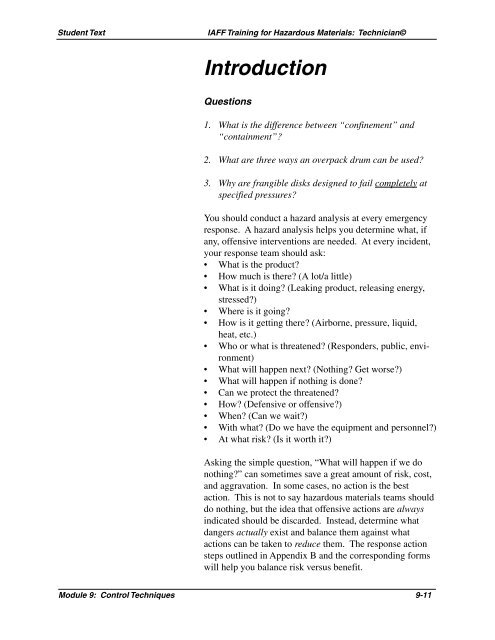Module 9: Control Techniques - International Association of Fire ...
Module 9: Control Techniques - International Association of Fire ...
Module 9: Control Techniques - International Association of Fire ...
Create successful ePaper yourself
Turn your PDF publications into a flip-book with our unique Google optimized e-Paper software.
Student Text IAFF Training for Hazardous Materials: Technician©<br />
Introduction<br />
Questions<br />
1. What is the difference between “confinement” and<br />
“containment”?<br />
2. What are three ways an overpack drum can be used?<br />
3. Why are frangible disks designed to fail completely at<br />
specified pressures?<br />
You should conduct a hazard analysis at every emergency<br />
response. A hazard analysis helps you determine what, if<br />
any, <strong>of</strong>fensive interventions are needed. At every incident,<br />
your response team should ask:<br />
• What is the product?<br />
• How much is there? (A lot/a little)<br />
• What is it doing? (Leaking product, releasing energy,<br />
stressed?)<br />
• Where is it going?<br />
• How is it getting there? (Airborne, pressure, liquid,<br />
heat, etc.)<br />
• Who or what is threatened? (Responders, public, environment)<br />
• What will happen next? (Nothing? Get worse?)<br />
• What will happen if nothing is done?<br />
• Can we protect the threatened?<br />
• How? (Defensive or <strong>of</strong>fensive?)<br />
• When? (Can we wait?)<br />
• With what? (Do we have the equipment and personnel?)<br />
• At what risk? (Is it worth it?)<br />
Asking the simple question, “What will happen if we do<br />
nothing?” can sometimes save a great amount <strong>of</strong> risk, cost,<br />
and aggravation. In some cases, no action is the best<br />
action. This is not to say hazardous materials teams should<br />
do nothing, but the idea that <strong>of</strong>fensive actions are always<br />
indicated should be discarded. Instead, determine what<br />
dangers actually exist and balance them against what<br />
actions can be taken to reduce them. The response action<br />
steps outlined in Appendix B and the corresponding forms<br />
will help you balance risk versus benefit.<br />
<strong>Module</strong> 9: <strong>Control</strong> <strong>Techniques</strong> 9-11
















